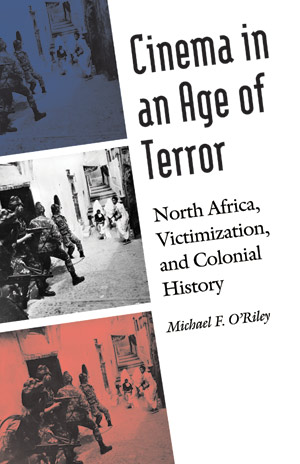
This book is about the ways that cinema teaches us how the idea of occupying the position of the victim is central to the dynamics of terrorism.
I became interested in the ways that the terrorized and the terrorizing seemed to share the common desire to occupy the position of the victim—to be seen as the victim—as a way of justifying their victimization.
Examining a number of films focusing on colonial history in North Africa that focused on images of victimization, it occurred to me that the visual aspect of victimization was important to the dynamics of terrorism. I began to examine, in particular, how films focusing on the images and spectacles of victimization that took place within colonial history might inform our understanding of terrorism today.
Cinema in an Age of Terror argues that films focusing on colonial-era victimization and terror enable us to see how victimization is very much about territory—cultural, spatial, and ideological.
So, while many films highlighting the terrorism of colonial history often focus on victimization as a way of producing a new or more complete version of history, I argue that they ultimately remain locked in a history that opposes torturer and tortured, victim and victimizer. I argue that, fundamentally, this vicious cycle is very much aligned with the dynamics of terrorism today and points to the centrality of the ideology of victimization within it.
“I became interested in the ways that the terrorized and the terrorizing seemed to share the common desire to occupy the position of the victim—to be seen as the victim—as a way of justifying their victimization.”
I became interested in this topic because of previous research I had done on postcolonial theory. The book engages deeply with postcolonial theory and the interest in that discipline in bringing to light past injustices.
Much of postcolonial theory seeks to side with the position of the victim. Revealing the victim’s position is predicated upon the idea that the victim was rendered silent throughout much of colonial history and was unable to speak.
The era of decolonization enabled the colonized to speak, to represent their victimization at the hands of the colonizer. A good deal of that victimization took the form of terrorism and torture. A very empowering moment for the formerly colonized and their advocates was the advent of postcolonial theory; it enabled the representation of this once voiceless past to come into existence and, in a sense, to revise how history was viewed.
A good part of my career so far has been focused on the ways that postcolonial theory has been focused on images of the victim and the victimizer. An attempt to return those images to the present, to inscribe them and their moments of terror visually within the contemporary context seemed to me to be a central objective of postcolonial theory.
Although I undoubtedly deem this to be an important gesture, it also seems highly problematic. It raises the question of whether past oppositions and antagonisms are really ever transgressed, or whether they continue to be replayed.
If the dynamics of victimization from the past are replayed, what new types of relationships between the formerly colonized nation and the formerly imperialist nation can truly be forged? Would it be possible to break out of this cycle or would it simply engender a new generational opposition? Would this focus on victimization really enable a new type of history to emerge, in particular between the “West” and formerly colonized nations?
Much of the interest of postcolonial theory in determining what constitutes the West and its Other and, in particular, what divides them, seemed central to many of these questions for me. The putative “clash of civilizations,” opposing the “West” and its “Other,” that has been referred to widely in the wake of September 11 seemed to align with this geopolitical slant of postcolonial theory.
My interest in films focusing on the colonial era, where the “West” and the formerly colonized nation were underscored, seemed based on just such an opposition, a struggle that opposed the West and its Other, victim and victimizer, torturer and tortured. Such oppositions led me to consider how these images from colonial history might inform our understanding of terrorism and its structure of victimization.
I’d draw the attention of your “browser” to the book’s first chapter.
The first chapter of Cinema in an Age of Terror discusses The Battle of Algiers, a film by the Italian Marxist director Gillo Pontecorvo. The film highlights the reciprocal victimization of the French and Algerians during the closing years of French colonialism in Algeria. It contains a rather graphic portrayal of terrorism as it is inflicted by both colonizer and colonized.
In late summer of 2003, when resistance to the American occupation in Iraq acquired the profile of a war of guerilla insurgency through increased bombings and acts of sabotage, the office of Special Operations and Low-Intensity Conflict of the Pentagon prepared a special screening of Pontecorvo’s film for Pentagon officials involved in the war on terror.
Although The Battle of Algiers clearly seems to side with the colonized Algerians in their struggle for independence, it definitely portrays how victimizer and victimized become locked in a cycle of victimization that becomes self perpetuating.
So the first chapter of my book examines the dynamics of victimization and spectatorship that link colonial-era history to the history of terrorism in the present.
In particular, I deal with the ways that the Pentagon screening of the film was directly related to occupying the position of the victim. In the wake of September 11th the U.S. identified clearly with the position of the terrorized victim.
The Pentagon screening of Pontecorvo’s film was an attempt on the part of the U.S. government to understand better the position and tactics of what it perceived to be the victimizer—the Arab Muslim insurgent in this film’s case. However, such a perception also revealed how the U.S. was placing itself in the position of victim.
The book not only discusses the fairly unknown use of a film on colonial history by the U.S. government, but it also demonstrates the importance of victimization within terrorism that my work attempts to underscore.
“The cultural and theoretical works I examine might demonstrate, in a larger sense, how our decision to adopt or renounce the victim’s position may be central to the perpetuation of a historical cycle of violence and opposition.”
Ideally, Cinema in an Age of Terror would enable some concerted reflection on the ways that reciprocal victimization structures terrorism.
More importantly, it might enable an understanding of how terrorism might be seen as a contest over the ideological territory of the victim.
Focusing, as it does, on such contests, the book demonstrates that victimization is central to the ways we see and create terror as well.
The cultural and theoretical works I examine might demonstrate, in a larger sense, how our decision to adopt or renounce the victim’s position may be central to the perpetuation of a historical cycle of violence and opposition.


Michael O’Riley is Associate Professor of French and Italian at The Colorado College. Besides Cinema in an Age of Terror, featured in his Rorotoko interview, he is the author of Francophone Culture and the Postcolonial Fascination with Ethnic Crimes and Colonial Aura and Postcolonial Haunting and Victimization: Assia Djebar’s New Novels. Michael O’Riley has been the recipient of a National Endowment for the Humanities grant for his work on cultural memory.